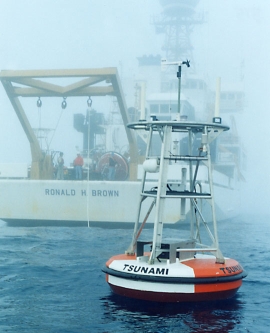The alarm system in the Pacific
The Pacific Tsunami Warning Center (PTWC) is the operational centre of the Tsunami Warning System in the Pacific (PTWS). Its headquarters are in Hawaii. The PTWS has 150 seismic stations located all round the world and receives signals from about 100 stations that measure variations in the sea level. The system sends information and warning messages to authorised centres in countries on the Pacific coast. As well as the PTWC there are other warning centres such as the West Coast/Alaska Tsunami Warning Center in the USA, the Sistema Nacional de Alarma de Maremotos in Chile, the Japan Meteorological Agency’s centre in Japan and the Yuzhno-Sakhalinsk Tsunami Warning Center in Russia.
 Fig. 1: A tsunami monitoring system off the coast of Alaska. The buoy transmits to a satellite the signal coming from a system positioned on the sea bed, which records variations in pressure. (Credit: Deep-ocean Assessment and Reporting of Tsunamis - NOAA) |
When the seismic stations of the network record an earthquake of a certain magnitude, with an epicentre in the area of the Pacific, the PTWC is put on the alert. If the magnitude is between 6.5 and 7.5 an information bulletin is issued to member countries. If the magnitude is more than 7.5, an alert bulletin is issued advising of the possibility that a tsunami has occurred, and those countries in reach of the tsunami in the first 6 hours are put on a state of alarm. In an alert situation, data from the the tide-gauges are continuously checked. If the sensors record the presence a tsunami, a bulletin confirming the alarm is sent. If the analysis of the data transmitted in real time to the PTWC indicates that the tsunami is transoceanic, the bulletin is extended to the entire Pacific. The state of alert lasts until the danger is over.
 |
Fig. 2: A DART instrument. A pressure recorder is positioned on the sea bed and with an acoustic channel it sends data to the buoy linked to it. Then, the buoy sends the signals to the data acquisition centres. (Credit: Deep-ocean Assessment and Reporting of Tsunamis - NOAA) |
Buoys
As we have already mentioned, a tsunami alarm system consists of a seismic
network which picks up earthquakes that could possibly generate a
tsunami, of a
network of oceanographic stations and of a data analysis centre. Apart from
stations such as tidi-gauges installed near the coast, the marine
monitoring system can also use stations offshore. The stations, such as
the DART system (Deep-ocean Assessment and Reporting of Tsunamis) shown
in Figures 1 and 2, are made up of a bottom pressure recorder positioned
on the sea bed and a buoy on the sea surface; at set intervals, the sensor takes the pressure
and sends the data acoustically to the buoy, which is connected by satellite to
the control centre. When an alarm situation is detected the system increases
the frequency of data sampling until the subsequent alarm-over signal.
The Webweavers: Last modified Tue, 1 Aug 2006 14:30:08 GMT